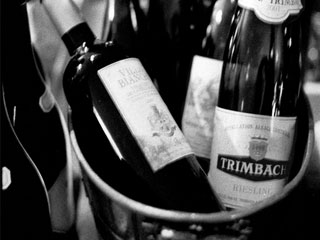Next story: Understanding the Concept
The Riesling Is
by Paula Paradise

What follows is my modest plea for sloughing off your comfortable, hand-knitted cardigan of a white—e.g. Chardonnay or Pinot Grigio—for just a few bottles of what might be the greatest white wine on this earth.
Consider, if you will, the staggering proof in favor of my thesis.
First, note the admirable hardiness of this noble grape. Because of Riesling’s phenomenal stamina, it can hang healthy on the vine well past the harvest time of other white grapes, all the while accumulating intensely high sugar levels and concentrated flavors. Depending upon the intent of the winemaker, these grapes may be partially or fully fermented, rendering a range of sweet to bone-dry wines. As tastes change and new trends push the market towards drier styles, winemakers are increasingly fermenting Riesling grapes dry, producing a light-bodied white suitable to be served with hors d’oeuvres, entrées or simply on its own—especially appealing on a sweltering summer day.
Secondly, while longevity is one criterion for great wines, most whites are short-lived. Chardonnays are commonly tired after three to five years. For Sauvignon Blancs, the outlook is even bleaker: They lose their freshness after just two years or so. Double the purchase price and the results will be little different. Even the famous white Burgundies of France, which will cost you dearly, have recently been criticized (specifically the 1996, 1997 and1998 vintages, in Decanter Magazine, April 2007) for their disappointing results in the cellar.
Chardonnay, Pinot Grigio and Sauvignon Blanc are shooting stars. There are few miracles among the 50-percent-off shelves packed with dusty bottles of these whites. Not so with Riesling! Cellar a $40 dry German or Alsatian Riesling (most are made with hand-harvested grapes from Grand Cru vineyards at this price point) and the fruit will seem exuberant even after 10 years. Of course, sweet German Rieslings at the Auslese or higher level (a German classification referring to the ripeness and quality of the fruit) will last decades, acquiring unearthly complexity…but never mind, you say—you’re not a sweet wine drinker.
The proof is in the bottle. Unparalleled in its complexity, ability to age and intensity of flavor, many wine experts, including Master of Wine Jancis Robinson, quietly opine that Riesling is the noblest white wine in the world. The aromas alone are worth the price of admission, evoking everything from white peaches, green apples, lime sorbet, apricots, lemon custard and crème brûlée to flowers and stone. I might weep at the beauty of this wine—so misused by greedy hands that merely turn out sugar water.
I admit that the Riesling vine, weakened by overproduction and blended with inferior grapes, will yield insipid wine—Liebfraumilch, for instance. However, it wasn’t the Germans’ taste for sweetness that led to the flood of sweet, inexpensive German whites into the US market in the 1950s. As is often the case when we attempt to lay blame on others, the responsibility lies closer to home: It was the American taste for sugary beverages that fueled the demise of the noble Riesling grape’s reputation. Ironically, Germans rarely drink sweet wine now nor did they back in the 1930s when German export brand wines were originally conceived for the UK and US markets. American soldiers stationed in Germany after the Second World War helped to popularize Liebfraumilch-type wines such as the Blue Nun.
The heyday of that little Nun came in the mid 1980s, with over a million cases sold in the US alone. I recall that my fancy college wine in the early 1980s came in a dark ceramic bottle—the Black Tower!
Thankfully, those dark times did not prevent great wines from being made and drunk and written about. And perhaps the lucrative business of cheap German whites kept the vines in the ground instead of being torn up for orchards or other food crops. During a visit to Germany in 2005, I tasted hundreds of Rieslings, some from as early as the first part of the 1900s, gorgeous reminders all of what makes wine much more than a beverage. In the dark, damp, centuries-old cellars, within nine-foot brick walls, in a room lit by candles so as not to disturb the sleep of the wine, we sipped the nectar quietly, elated.
So, what is Riesling? As usual, supply and demand are shady characters that obscure truth. It just may be that in its purest expression—dry, austere, luminous, yet richly textured and explosive on the palate—Riesling is what you want.
For quick satisfaction, here is a cheat sheet of some exceptional producers:
■ Domaine Wachau, Nigl—Austria;
■ Schloss Johannishof, Schmitges, Schumann Nägler, Dr. Loosen Blue Slate, Schlossgut Diel—Germany;
■ Zind Humbrecht, Trimbach—Alsace, France;
■ Chateau Lafayette Reneau, Dr. Frank, Standing Stone, Hunt Country—NY Finger Lakes;
■ Cave Spring, Inniskillin, Henry of Pelham—Canada.
|
Issue Navigation> Issue Index > v7n5: Mardi Gras 2008 (1/31/08) > The Riesling Is This Week's Issue • Artvoice Daily • Artvoice TV • Events Calendar • Classifieds |









 Current Issue
Current Issue